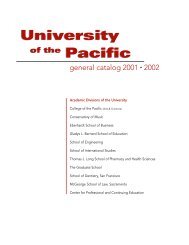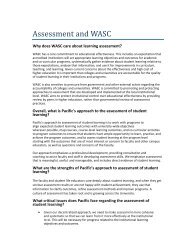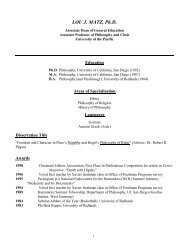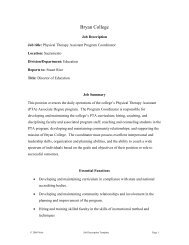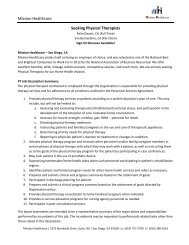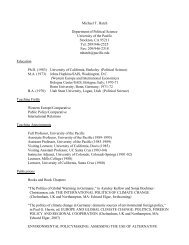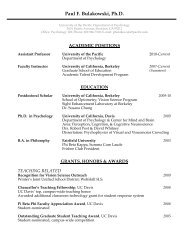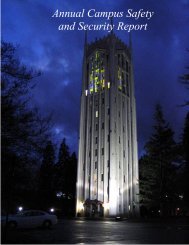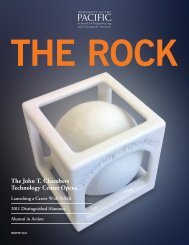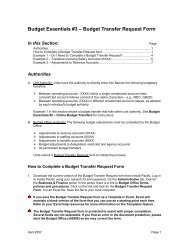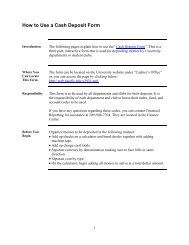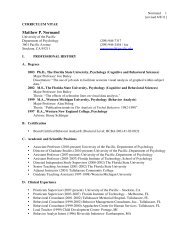purcc 2012 - University of the Pacific
purcc 2012 - University of the Pacific
purcc 2012 - University of the Pacific
Create successful ePaper yourself
Turn your PDF publications into a flip-book with our unique Google optimized e-Paper software.
Poster Session Abstracts<br />
engineering courses to produce a design in<br />
compliance with specifications and rules outlined<br />
by <strong>the</strong> National Student Steel Bridge<br />
Competition committee. Specifications dictated<br />
dimensional limits, construction restraints, and<br />
judging criteria. The bridge was judged by a<br />
panel <strong>of</strong> practicing engineers who evaluated<br />
performance categories including stiffness,<br />
aes<strong>the</strong>tics, construction, and sustainability.<br />
In <strong>the</strong> design phase, several bridge designs were<br />
modeled in RISA-3D structural simulation<br />
s<strong>of</strong>tware to evaluate structural performance<br />
under an applied load <strong>of</strong> 2500 pounds. A<br />
selection was made based on deflection and<br />
weight performance. Upon selection <strong>of</strong> <strong>the</strong><br />
optimal design, shop drawings were rendered in<br />
AutoCAD s<strong>of</strong>tware to determine material<br />
quantities. Following fundraising, <strong>the</strong> team<br />
purchased <strong>the</strong> necessary tools and materials to<br />
begin <strong>the</strong> fabrication process. Students cut,<br />
welded and drilled steel parts while<br />
incorporating innovative dovetail connections to<br />
allow for rapid construction with minimal<br />
deflections. These design features allowed <strong>the</strong><br />
students to construct <strong>the</strong> bridge in approximately<br />
27 minutes. Loading <strong>the</strong> bridge with 2500<br />
pounds yielded 1.1 inches <strong>of</strong> vertical deflection,<br />
and a 50-pound lateral pull produced less than<br />
0.5 inches <strong>of</strong> deflection. The strong structural<br />
performance was echoed by a fierce aes<strong>the</strong>tic<br />
presence, consisting <strong>of</strong> an orange truss, marked<br />
with black stripes mimicking that <strong>of</strong> a tiger’s<br />
back.<br />
An Assessment <strong>of</strong> <strong>the</strong> Total Phosphorous<br />
Mass Balance Using a Modified<br />
Persulfate Digestion Method<br />
Mat<strong>the</strong>w Ebia<br />
Faculty Mentor: William Stringellow<br />
Chelsea Spier (graduate student)<br />
California ranks first in <strong>the</strong> nation in municipal<br />
solid waste, sewage sludge, dairy manure, and<br />
food processing waste generation. This waste has<br />
undeveloped potential biogas generation capacity<br />
estimated at 600 Megawatts. Utilizing <strong>the</strong>se<br />
wastes to produce biogas for energy production<br />
could help California meet state renewable<br />
energy goals and greenhouse gas emission<br />
reduction targets. The Ecological Engineering<br />
Research Program (EERP) is working with<br />
Fiscalini Farms, a California dairy, to develop<br />
best available control technology for biogas<br />
combined heat and power systems and collect<br />
system performance data for future use to<br />
advance <strong>the</strong> science, technology, and market<br />
penetration in California. A mass balance <strong>of</strong><br />
nitrogen, sulfur, carbon, salts, and solids is being<br />
developed. Samples collected as part <strong>of</strong> this<br />
mass balance include a mixture <strong>of</strong> slurry and<br />
solids. Slurry samples have been measured for<br />
total phosphorous (TP) since <strong>the</strong> beginning <strong>of</strong><br />
<strong>the</strong> project using a modified persulfate digestion<br />
followed by an ascorbic acid reaction, which<br />
allows for colorimetric determination <strong>of</strong> TP. For<br />
my part <strong>of</strong> this project, I am developing a new<br />
method for TP determination on solid samples<br />
based on standard methods because <strong>the</strong> previous<br />
method was determined to be insufficient for<br />
many sample types. Once this method is<br />
developed all archived solid samples will be<br />
measured and TP will be included as part <strong>of</strong> <strong>the</strong><br />
mass balance. The mass balance is critical to <strong>the</strong><br />
long term sustainability <strong>of</strong> <strong>the</strong> system because<br />
nearly all wastes entering <strong>the</strong> system remain on<br />
site and are ultimately applied to <strong>the</strong> fields as<br />
fertilizers.<br />
Solving <strong>the</strong> low dissolved oxygen problem<br />
by understanding <strong>the</strong> sources and fate <strong>of</strong><br />
different nitrogen species entering in <strong>the</strong><br />
San Joaquin River Estuary<br />
Ernest A. Garcia<br />
Faculty Mentor: William Stringfellow<br />
Stockton’s deepwater ship channel (DWSC) has<br />
been suffering from low dissolved oxygen for<br />
decades, especially in dry water years. The<br />
Ecological Engineering Research Program<br />
(EERP) has been <strong>the</strong> lead science agency on <strong>the</strong><br />
Dissolved Oxygen (DO) Total Maximum Daily<br />
Load (TMDL) project since 2005. The purpose<br />
<strong>of</strong> this project is to collect and analyze data on<br />
<strong>the</strong> sources <strong>of</strong> nutrients, phytoplankton and<br />
oxygen-consuming materials in <strong>the</strong> San Joaquin<br />
River (SJR) estuary, <strong>the</strong> upstream SJR, and<br />
upstream tributaries to support <strong>the</strong> development<br />
<strong>of</strong> an estuary model. This model is needed by <strong>the</strong><br />
Central Valley Regional Water Quality Control<br />
Board (Regional Board) to provide modeling<br />
tools, scientific data and o<strong>the</strong>r information to<br />
support management actions that will be taken<br />
by <strong>the</strong> Regional Board and stakeholders to<br />
resolve <strong>the</strong> low DO problems in Stockton’s<br />
DWSC. For my part in this project, I have been<br />
responsible for measuring ammonia, nitrate, and<br />
total nitrogen in samples collected in 2011 as<br />
44



